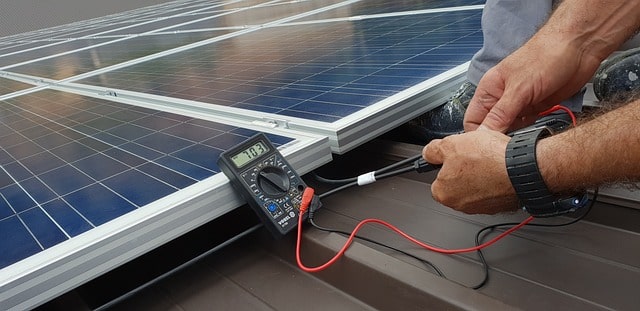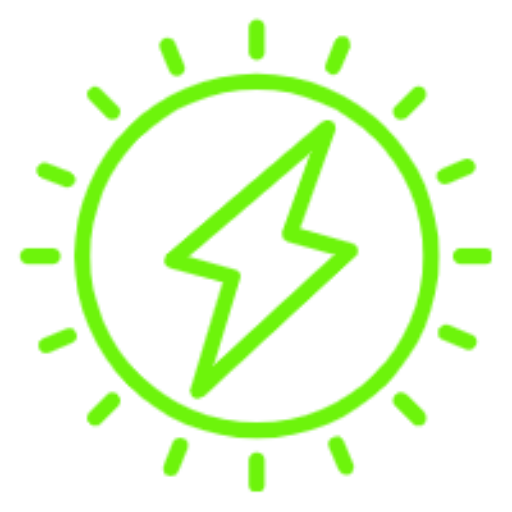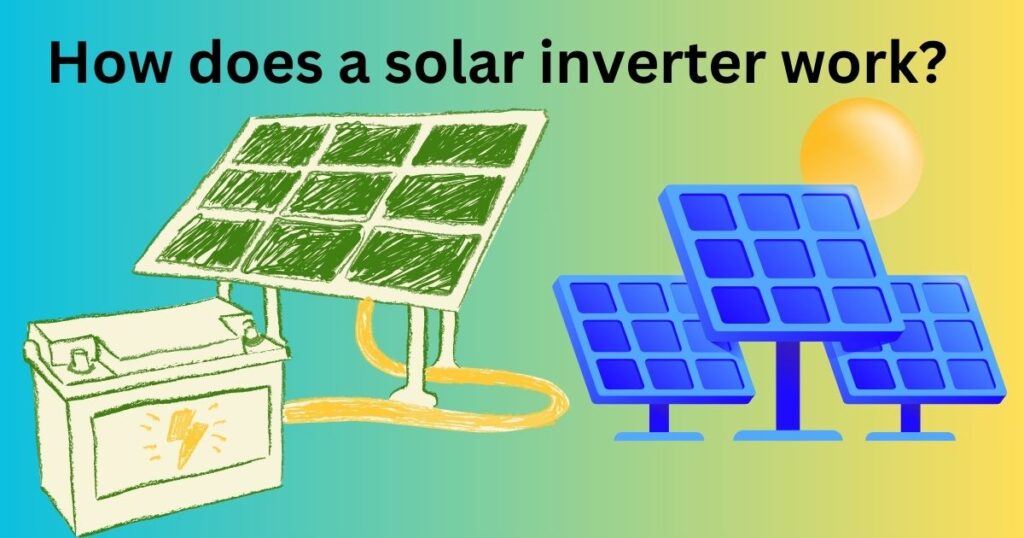Last updated on March 22nd, 2025 at 11:33 am
A solar inverter is an essential component of a solar power system, but how does a solar inverter work?
A solar inverter is a crucial device that converts the direct current (DC) electricity produced by solar panels into alternating current (AC) electricity, which is used by most home appliances and the electrical grid.
Understanding how a solar inverter works is crucial for anyone interested in solar energy, as it plays a vital role in ensuring the efficiency and functionality of a solar power setup.
After reading this article, you’ll understand how does a solar inverter work, its function and importance in a solar power system, the different types available, and the key features to consider when selecting one for your solar energy system.
- Solar inverters convert DC electricity from solar panels into AC power that’s used by homes and businesses.
- MPPT technology maximizes energy production, ensuring panels operate efficiently under different conditions.
- Different types of inverters—string, micro, hybrid—suit different system needs based on size, performance, and budget.
- Regular maintenance and monitoring help keep solar inverters running efficiently and extend their lifespan.
Types of Solar Inverters
There are several types of solar inverters, each with unique characteristics, advantages, and disadvantages. Understanding these types can help you choose the right inverter for your solar energy system.
String Inverters
String inverters are the most commonly used type of inverter in residential and commercial solar installations. They function by connecting a series of solar panels, referred to as a “string,” into a single inverter unit.
The direct current (DC) electricity generated by all the panels in the string is sent to the string inverter, where it is converted into alternating current (AC) electricity for use in homes and businesses.
This setup is straightforward and cost-effective, especially for installations where the panels are all facing the same direction and have consistent sunlight exposure.
However, string inverters have some limitations, particularly their sensitivity to shading. If one panel in the string is shaded or underperforms, it can reduce the output of the entire string, affecting overall energy production.
Microinverters
Microinverters are a more advanced type of inverter that is installed on each individual solar panel, allowing for the conversion of DC to AC electricity at the panel level.
This design means that each solar panel operates independently, which provides a significant advantage in terms of system performance and flexibility. With microinverters, the impact of shading, dirt, or panel mismatches is minimized, as each panel is optimized separately.
This makes microinverters ideal for installations where panels are installed on multiple roof planes or in areas with partial shading.
The main drawback of microinverters is their higher cost, as each panel requires its own inverter, increasing equipment and installation expenses. However, their ability to optimize each panel’s output and provide detailed monitoring often outweighs these costs.
Hybrid Inverters
Hybrid inverters are versatile devices that can manage power from multiple sources, including solar panels, batteries, and the electrical grid.
These inverters are designed to work seamlessly with battery storage systems, allowing homeowners to store excess solar energy for use during times when the solar panels are not producing electricity, such as at night or during power outages.
Hybrid inverters can switch between grid-tied and off-grid modes, providing flexibility and ensuring a continuous power supply.
Hybrid inverters offer the advantage of integrating energy storage, providing backup power and increased energy independence, but they come with higher costs and require more complex installation.

How Does a Solar Inverter Work? Step-by-Step Process
Step 1: Conversion Process
The main function of a solar inverter is to convert the direct current (DC) generated by solar panels into alternating current (AC), which is what most appliances use. This process starts when solar panels absorb sunlight and generate DC electricity. Since DC can’t be directly used in homes, the solar inverter steps in.
Inside the inverter, transistors and other electronic components rapidly switch the DC current on and off, creating a waveform. This waveform is then shaped into an AC output through a series of transformations.
Transformers inside the inverter help adjust the voltage levels to ensure that the AC output matches the required grid voltage. Finally, the inverter smooths out the electrical signal to create a clean, usable form of AC electricity.
Step 2: Technical Details
The conversion relies on several key components. Transistors are responsible for switching the DC current on and off, while capacitors help filter and smooth the electrical flow. Transformers adjust the voltage and isolate the system to protect it from power surges.
The inverter’s processor controls all these parts, ensuring the conversion happens efficiently. The result is a clean and stable AC current that can be used to power your home or be sent back to the grid.
Step 3: Synchronization with Grid Power
Grid-Tied Inverters
Grid-tied inverters not only convert DC to AC but also synchronize with the local power grid. They ensure that the electricity produced by your solar panels matches the voltage and frequency of the grid. When your system generates more electricity than your home needs, the excess is sent back to the grid.
This allows you to earn credits through net metering. If your system produces less than needed, the inverter pulls electricity from the grid to make up the difference, ensuring a seamless flow of power.
Off-Grid Inverters
Off-grid inverters operate independently from the grid. They are typically used in systems with battery storage, where the inverter manages energy flow between the solar panels, batteries, and your home. During the day, solar panels charge the batteries, and the inverter supplies power to your home.
At night or when sunlight is low, the inverter draws power from the batteries to keep your system running smoothly. Off-grid inverters are designed to handle energy storage and usage without relying on grid electricity.
Key Features and Technologies in Modern Solar Inverters
Maximum Power Point Tracking (MPPT)
MPPT, or Maximum Power Point Tracking, is a key technology in modern solar inverters that ensures your solar panels operate at their best. Solar panels produce varying amounts of power depending on sunlight conditions, temperature, and shading.
MPPT helps the inverter find the “sweet spot” where the panels produce the maximum possible power. By continuously adjusting the electrical load, MPPT ensures that even in less-than-ideal conditions, your solar system still generates as much energy as possible.
Efficiency Ratings
Solar inverters come with an efficiency rating that tells you how effectively they convert DC power from your solar panels into usable AC power. This rating is usually given as a percentage, showing how much of the energy generated is lost during conversion.
For example, an inverter with 95% efficiency loses 5% of the energy during conversion. The higher the efficiency, the less energy is wasted. This means more of your solar power gets used, leading to better performance and savings on your electricity bills.
Safety Features
Modern inverters come packed with safety features to protect both your system and the grid. One of these is anti-islanding, which automatically shuts off the inverter if the grid goes down, preventing energy from flowing back into the grid during an outage.
Ground fault protection detects electrical faults and prevents potential hazards, like short circuits. Another important feature is rapid shutdown, which allows the system to quickly power down in emergencies, like fires, to ensure the safety of firefighters and technicians.
Smart Inverters
Smart inverters take solar technology to the next level by adding advanced communication capabilities. These inverters can “talk” to the grid, helping balance power supply and demand more efficiently.
They can also monitor your system’s performance in real-time and send updates to your phone or computer, making it easier to track energy production, spot issues, and optimize performance.
Factors to Consider When Choosing a Solar Inverter
System Size and Configuration
When choosing a solar inverter, it’s crucial to consider the system size and configuration. The inverter must be compatible with the size and type of your solar panel system.
For example, a large system with many panels may require a more powerful inverter to handle the energy output, while smaller systems might use a simpler, lower-capacity inverter.
Matching the inverter’s capacity to your solar panels ensures optimal performance and avoids overloading or underutilizing the inverter.
Efficiency and Performance
Efficiency is another key factor when selecting a solar inverter. Higher efficiency ratings mean the inverter can convert more DC power into usable AC power, which improves your overall energy production.
It’s also important to consider how well the inverter performs under different conditions, such as partial shading or high temperatures. Inverters with technologies like MPPT (Maximum Power Point Tracking) can adapt better to varying conditions, ensuring your system operates efficiently at all times.
Cost and Warranty
The cost of the inverter is a significant factor, but it’s important to look beyond just the upfront price. A higher-quality inverter may cost more initially but could save you more in the long run through better performance and durability.
Additionally, inverters come with varying warranty terms, typically ranging from 5 to 25 years. A longer warranty period provides peace of mind and can protect your investment by covering potential repairs or replacements down the line.
Installer Recommendations
Lastly, it’s always a good idea to get professional advice from solar installers. They have experience with different inverter brands and models and can recommend the best option based on your specific system and needs
An installer will also ensure that the inverter is installed correctly and meets local regulations, which is essential for safety and optimal performance.
Maintenance and Troubleshooting of Solar Inverters
Regular Maintenance
Keeping your solar inverter well-maintained ensures it performs efficiently over its lifespan. One simple maintenance tip is to regularly check for dust and debris around the inverter, as buildup can cause overheating or reduce performance. Make sure the area around the inverter is clear, and inspect it occasionally for any physical damage.
Another important step is to monitor its performance regularly. Many inverters have built-in monitoring systems or apps that track energy output—keeping an eye on this can help spot issues early before they become serious problems.
Common Issues
Solar inverters can experience a few common issues, which you can often troubleshoot yourself. One of the most frequent problems is connectivity issues with the monitoring system, which can sometimes be resolved by resetting the inverter or checking your internet connection.
Error codes are another issue, and while they can vary by brand, many inverters have a guide or manual that helps explain what each code means. Overheating is also a concern, especially if the inverter is exposed to direct sunlight or poor ventilation. In such cases, ensuring proper airflow or relocating the inverter may help resolve the issue.
When to Call a Professional
While some minor issues can be handled with basic troubleshooting, there are times when it’s best to seek professional help. If the inverter displays persistent error codes that you cannot resolve or if it fails to convert power altogether, it’s time to call an expert.
Additionally, if there are any electrical faults or signs of burning, sparking, or other hazards, avoid handling the inverter yourself. A professional can diagnose the issue more accurately, perform repairs, or replace the inverter if necessary.
Conclusions
Solar inverters are crucial for turning the DC electricity from solar panels into the AC power that homes and businesses use. They improve efficiency with technologies like MPPT and, in grid-tied systems, work with the power grid to manage energy flow.
Off-grid inverters handle power storage and distribution on their own. By understanding how solar inverters work, you can choose the right one for your system and keep it running efficiently.
Frequently Asked Questions (FAQs)

